IT guy on vacation: add some astronomy?
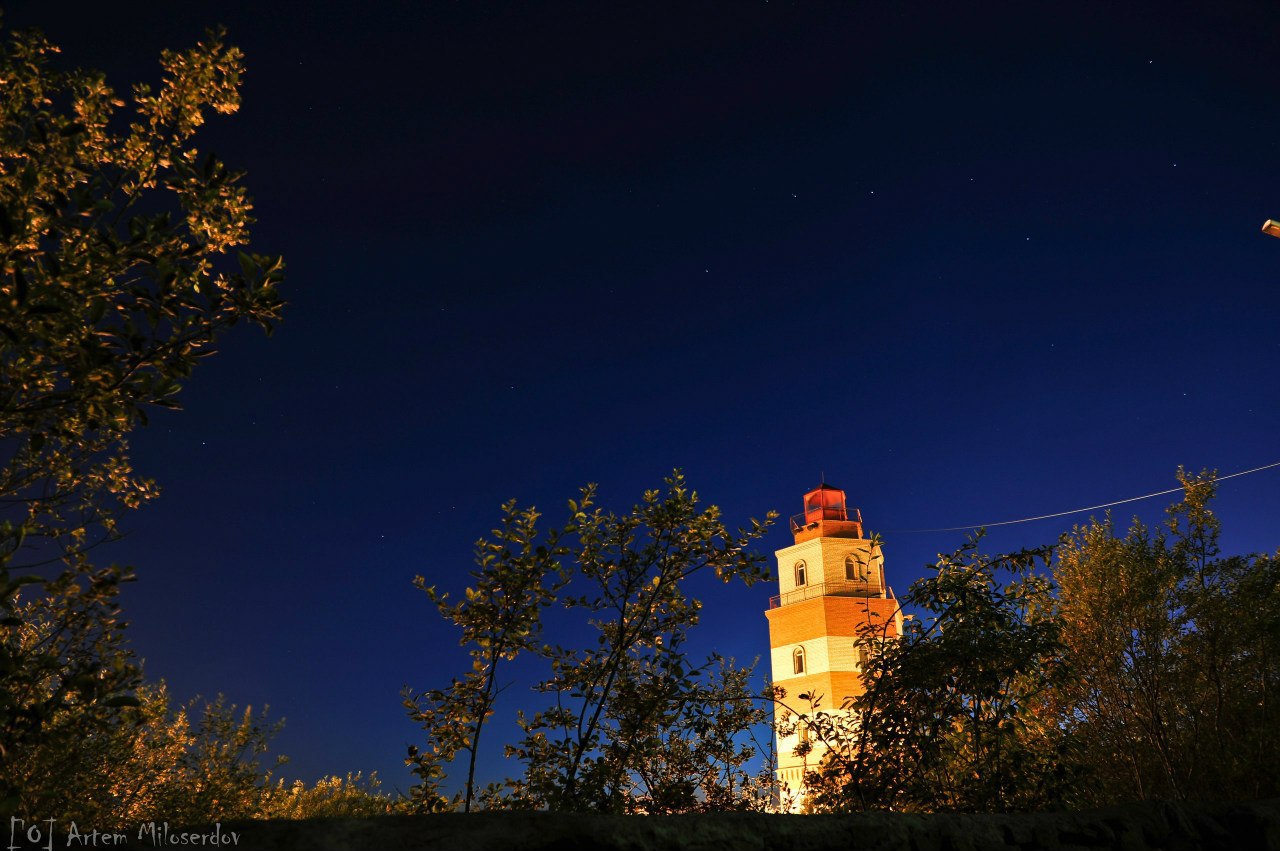
Summer is rapidly approaching and the accompanying field trips. The gatherings are delayed at midnight, and the stars appear above the head. But, as a rule, the starry sky is mysterious and incomprehensible - astronomy has not been taught in schools properly, probably since the late 80s, and who remembers what it was taught in school if it was not used in life all the time? And in the sky there is enough interesting, especially if you spend a little time on the astronomical support of going on nature.
Introduction
In this post several scenarios are considered depending on your equipment with software and monitoring tools.
Scenario one - empty hands and the naked eye
I got a battery at my smartphone, or you didn't take it with you at all. But you read this post and you have a good memory. And in this case, you can show something / tell.
Big Dipper, Polaris, Cassiopeia
Raise your head up. Almost at the zenith (for the territory of Russia until mid-summer) there will be a characteristic Ursa Major bucket. If you continue the straight line of the two farthest stars from the bucket handle, the first bright star, at a distance of about five heights of the bucket, will be the Polar Star. It indicates the direction to the north, and by its height one can recognize its latitude. She is also the most extreme star of the handle of the Little Dipper. If you continue the line further, then Cassiopeia will be closer to the horizon. The letter "W" is formed by fairly bright stars and is visible quite well.
')
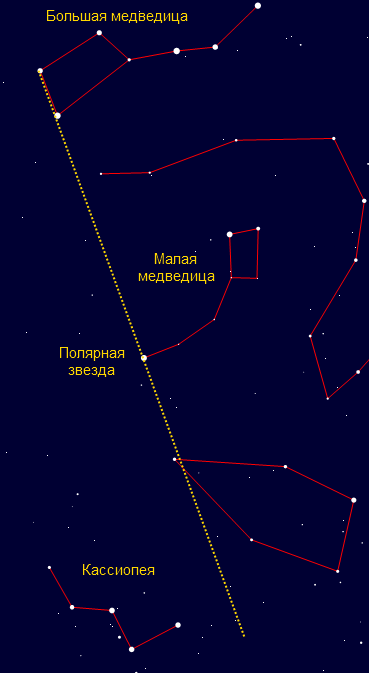
The company can check your visual acuity (or the quality of the selection of glasses :)). To make the contest more or less fair, I suggest the following wording: “One of the stars of the handle of the Big Dipper’s bucket is double, and a person with sharp eyesight can see two stars - Mizar and Alkor. If you see two stars, name its number from the edge of the bucket. ”
Correct answer
The second star from the edge of the handle:


Swan, Lyra, Eagle
In the east, to the right of Cassiopeia, are the constellations Cygnus and Lyra. The swan is a slightly oblique cross, is also very clearly visible. The constellation of Lyra is worse, but Vega is very bright. Every day of the summer, they will rise higher and higher, and soon the Eagle constellation will appear. Three constellations contain one bright star, which form a so-called. Summer-autumn triangle:
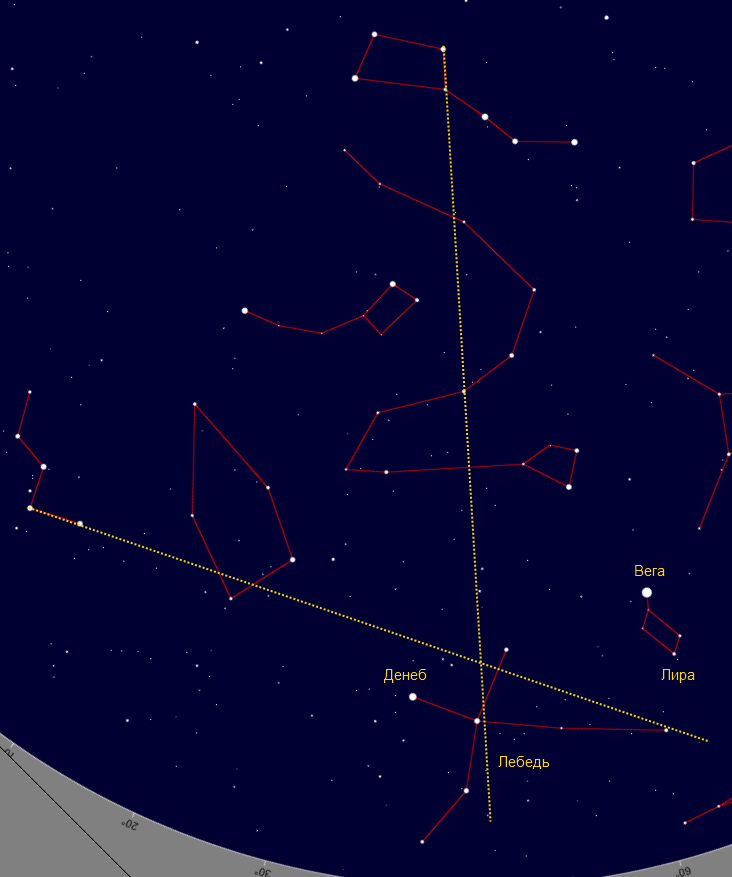
Early may

Early July
Arcturus, Speke, Regulus, Saturn, Mars
We continue to turn right. In the south we will have the bright stars Arcturus, Spica, Regulus and, in 2014, the planets Mars and Saturn. This sector is bounded by straight lines drawn from the handle of the Big Dipper bucket and the wall nearest to the handle. Arcturus is the constellation Bootes, Speke is Virgo, and Regulus is Leo.
Saturn and Mars will gradually move across the sky, they can be distinguished from the stars by the absence of flicker.
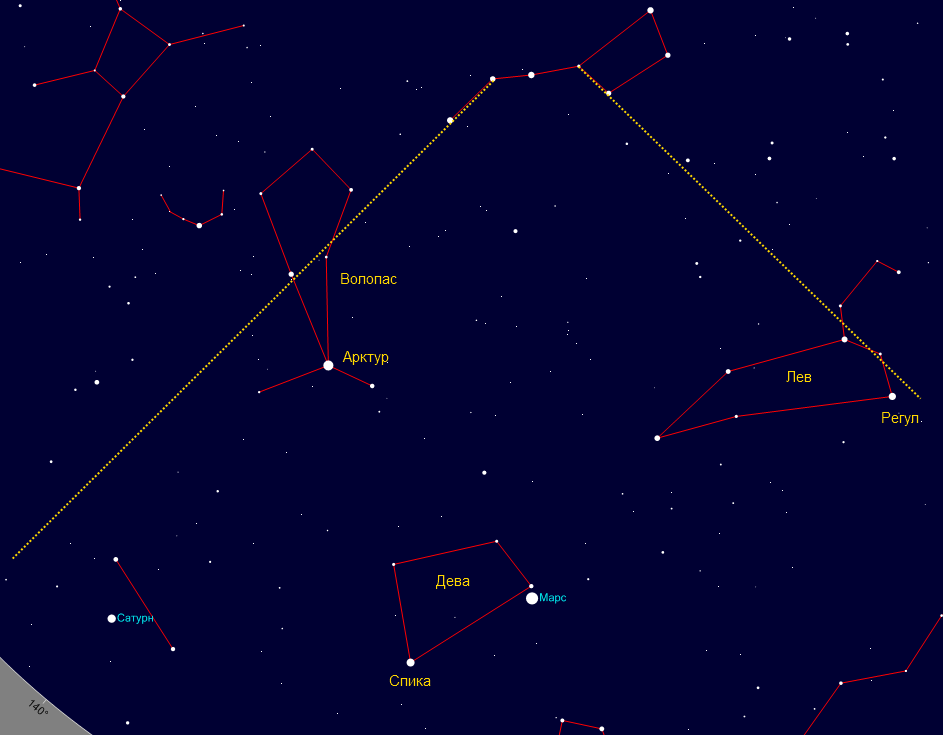
Early may
Castor, Pollux, Procyon, Capella, Jupiter
The last section is west and northwest. Here in 2014, Jupiter will be very bright, which will decline until it disappears completely by July. Two stars just above are Castor and Pollux, the constellation of Gemini. Left-below will be Procyon, the constellation of the Little Dog, on the right - the Chapel, the constellation Auriga. Hurry to see it, in the next month or two it will all go under the horizon and appear already in the east on October evenings.

There are still objects that are visible to the naked eye, but it makes no sense to talk about them now. The Pleiades had already disappeared, and will be visible in the morning in August, the Andromeda Nebula is low in the north and hard to see until the same August. The great Orion Nebula will be visible in the morning in the fall.
Scenario two - I'm not too lazy to prepare
There are objects that are visible to the naked eye, but their position must be calculated. Venus and Mercury appear in the evening, then in the morning, and to know where they will be, you should use the software or Internet resources. The same applies to the moon, if we do not follow the sky and do not notice its phase.
Stellarium
Probably the most popular desktop planetarium. The program is free, open source, with Russian, there are builds for Win, Mac, Linux.
http://www.stellarium.org/ru/
The interface is very simple:

Before using, you need to set your location, pay attention to the screenshot. After setting the location, you can set the right time through the "Date and time" window or the rewind buttons and look at what will be in the sky.
Heavens-above.com
Very useful resource, recently Russified.
http://heavens-above.com
It is also necessary to set your location.

In addition to the star map for the selected location, this resource has some very useful features:
ISS
The MKS is a very bright object in the sky. And, if you are lucky, it may be visible during your departure to nature. Resource heavens-above gives the forecast of the passage of the ISS for 10 days ahead.
Iridium flares
"Iridium" is a satellite communications system built on low-orbit satellites. In the construction of the satellite there are three very well reflecting light antennas the size of a door:

Satellite orientation is known. So, it is possible to calculate the moment when the sun's rays reflect from these antennas and fall to the Earth. An iridium flash can be the brightest in the sky if you are lucky enough to be in the right place. Therefore, I recommend to indicate your expected position quite accurately. The service even allows you to determine where to move, so that the flash is brighter:

The smaller the number in the Brightness cell, the better. The maximum brightness for Iridium is about -8.
There is also a map of the flash position in the sky to facilitate the search:

Scenario Three - I have a planetarium in my smartphone
In general, a planetarium in a smartphone is a useful thing. You walk around the city, you see a bright dot in the sky and check that Venus is on it, or again the
http://sideralis.free.fr/index.html

The program is pretty, there are only two more or less noticeable flaws - the absence of the Russian language, and the need to enter the coordinates of the location manually in the form of numbers, without searching by cities, or a map.
A small request : I would be grateful for your feedback in the comments about planetarium programs for Android, iOS, WP, if you used them. What programs used? What are they good for? What are the disadvantages? I think readers will be useful.
Scenario Four - Armed Eye
It is easy to take binoculars with you, and the availability of the sky is seriously increasing. What interesting objects can be seen with binoculars in the sky?
Moon
The armed eye of the moon is more impressive. Especially good to look at the moon in the first or last quarter, when the light falling at an angle reveals the details of the relief - craters, sea irregularities, and other beauty.
Hee / Ash Perseus
This is a very beautiful paired open cluster, visible, as they say, with the naked eye. Through binoculars, it should be seen even better.
If you draw a straight line from Cassiopaea’s second left W stick, then at a distance of 1-2 W stick lengths there will be Hi / Ash Persei - two piles of stars:
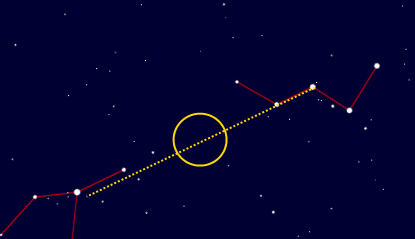
Specially I do not attach photos as it looks. Unfortunately, astrophotography taken with professional equipment looks better than can be seen even through a telescope, which can cause disappointment when seen live. But to find and see what is there, personally - this is already more interesting.
The constellation Cassiopeia is located on the Milky Way, I recommend just to look in the area - there should be a lot of stars.
Hercules Large Cluster
Not far from the intersection of the continuation of the handle of the Big Dipper bucket and the Deneb-Vega line is the constellation Hercules. The central trapezium is very clearly visible. Between the stars of the upper part of the trapezoid there is a small foggy ball - these are several hundred thousand stars at a distance of 265 thousand light years from Earth.
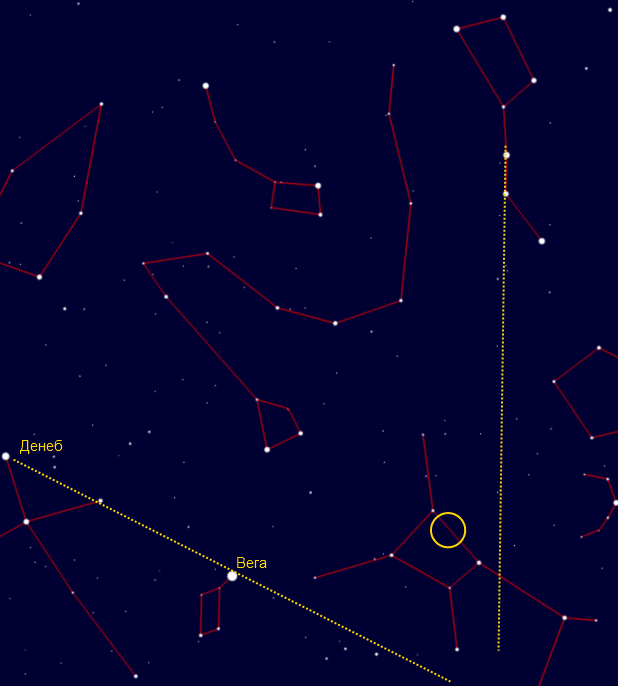
Epsilon lyra
An interesting multiple star in the constellation Lyra. Slightly to the left and above Vega there is a small asterisk. Two stars are visible through binoculars, and four stars through a telescope.

Manger
Between the constellations of Leo and Gemini is a dim constellation of Cancer. Approximately in its center there is an open cluster of the Manger (it is also the Hive). They claim that it can be seen even with the naked eye, which means it must be accurately visible through binoculars.
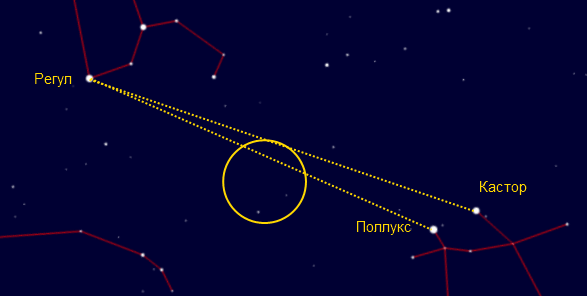
Andromeda's nebula
If you wait until June (or even better, July, or August at all), then in the morning the Andromeda Nebula, a neighbor of our galaxy, rises quite high. It is quite simple to find it - the curving line of stars is clearly visible, and the old friend Cassiopeia gives reference points:
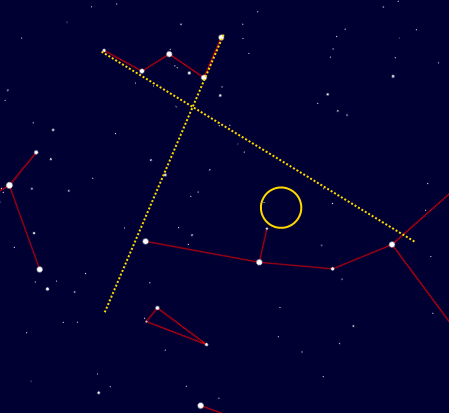
Pleiades
By the morning of August in the east will be very clearly visible several bright stars very close - this is the Pleiades. They can be seen well even with the naked eye. And in the binoculars should be visible bluish tint and a larger number of stars.
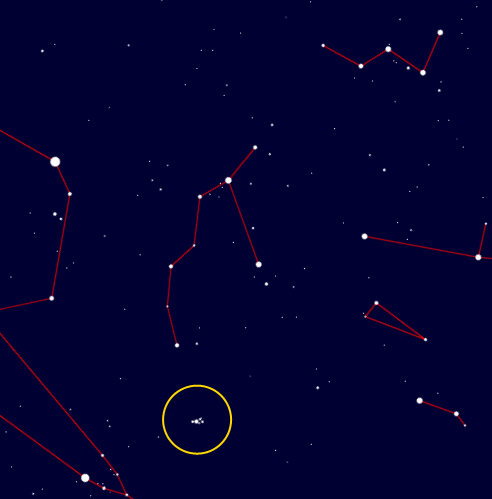
Great Orion Nebula
If anyone remembers this post in the fall, he can easily find the Great Orion Nebula. Orion itself is a very prominent constellation, with evening visibility already at the end of winter and early spring.

Conclusion
And to those who read to the end - a little more content for atmospheric - music by Andrey Klimkovsky:
http://klimkovsky-music.blogspot.ru/2013/07/0801.html
Information sources
- Thank you to the AstroAlert Observational Astronomy community for CDRV
- As a basis for the schemes used maps of heavens-above.com, Epsilon Lira scheme from Wikipedia.
- And then there is the AstroForum . In the post there are no quotes from there, but there is a lot of useful information.
Source: https://habr.com/ru/post/221683/
All Articles